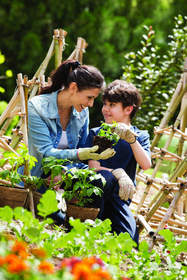MISSION, KS--(Marketwired - Mar 31, 2014) - (Family Features) The benefits of having your own backyard vegetable garden are plentiful, and can include significant lifestyle impacts, such as healthier eating habits, money saving perks and more.
A Relaxing, Healthful Hobby
Looking for a hobby that allows you to contribute to the health of your family? Take up gardening. Beyond producing nutritious foods, it can help you teach your family about local agriculture, all while basking in the tranquility of the great outdoors. Though starting your own home garden can be intimidating, there are a few simple steps to get you started. Once developed, it can yield fruits and vegetables from early spring and into the fall.
1) Do Some Research
Find out what vegetables grow best in your area and when is the right time to plant and harvest. Many local university extension programs have this information readily available online. For each plant, consider the amount of water needed, how much sunlight is required and if it should be started from seed or a transplanted seedling.
2) Choose a Good Spot
Keep in mind vegetables need at least six hours of sun each day, so plant away from the shade of buildings, trees and shrubs. Planting close to your house may make you more likely to bring your harvest right into your kitchen, and will help you remember to weed and water. Including rain and irrigation, your garden needs at least one inch of water per week. Make sure you can easily access a water supply nearby. Some products, such as an Ames NeverLeak hose reel, provide convenient hose storage and can easily reach all parts of your yard. Be sure to choose a level area of your yard so when watering it will not pool in lower areas.
3) Clear the Area
Use your garden hose or a string to mark the area for proper placement of your garden. Use a sod lifter or garden spade, keeping the area level and removing as little topsoil as possible. Next, use a round point shovel, such as the True Temper True American Round-Point Shovel, to dig into the soil about 12 inches, breaking it up and removing clumps. To encourage proper drainage and escape light freezes in early spring and fall, construct a raised bed by creating a border with wood slats and filling in with soil.
4) Prepare the Soil
Use a rake to create a smooth finish and remove debris or stones on the surface. You may want to add manure, compost or soil additives to provide additional nutrients in the soil.
5) Plant Your Seeds
Determine if you will be starting your plants from seeds or transplanting small seedlings. Be sure to research how much room each plant will need and plot the layout of your garden. Dig V-shaped furrows using a warren hoe or the edge of a garden hoe. Carefully distribute the seeds in the furrows evenly and in accordance with the instructions on the seed packet. Cover the seeds and pat down gently, then water thoroughly.
Use this information for a fruitful harvest this gardening season. For more tips, visit www.AmesTrueTemper.com or www.Facebook.com/TrueTemperTools.
About Family Features Editorial Syndicate
This and other food and lifestyle content can be found at www.editors.familyfeatures.com. Family Features is a leading provider of free food and lifestyle content for use in print and online publications. Register with no obligation to access a variety of formatted and unformatted features, accompanying photos, and automatically updating Web content solutions.
Contact Information:
Vickie Rocco
vrocco@familyfeatures.com
1-888-824-3337
http://editors.familyfeatures.com
